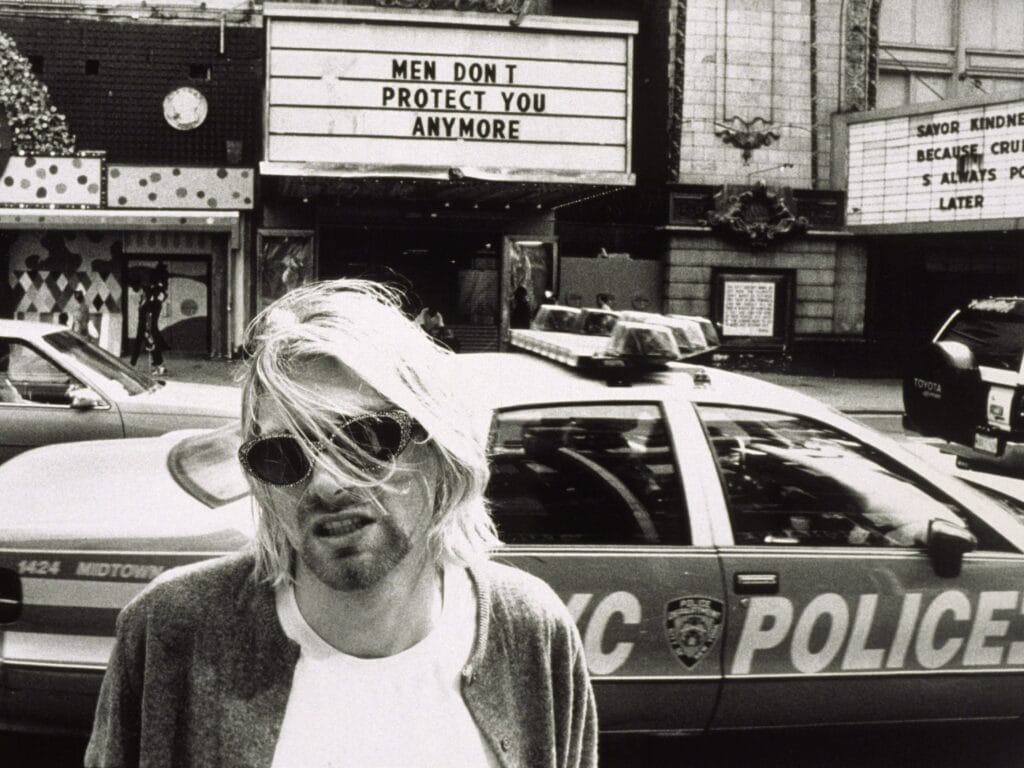Jenny Holzer stands as a pioneering figure in the realm of American neo-conceptual art, renowned for her innovative and provocative use of text within public spaces. Born on July 29, 1950, in Gallipolis, Ohio, Holzer’s formative years laid a unique foundation that would influence her artistic journey. Her educational endeavors began at Duke University, followed by further studies at the University of Chicago, ultimately culminating in her enrollment at the Rhode Island School of Design. This diverse academic background provided her with a robust platform to explore and develop her distinctive artistic voice.
Holzer’s work is characterized by the insertion of language into a variety of public and private locations, transforming conventional perceptions of both written word and its interaction with viewers. By utilizing mediums such as LED signs, billboards, posters, and projections, she challenges audiences to engage critically with her statements, often touching on themes of power, identity, and societal norms. This interaction between text and environment invokes a dynamic form of communication, distinguishing Holzer from her contemporaries and cementing her influence in contemporary culture.
As we unravel the evolution of her career and its impact on modern art, it becomes evident how Jenny Holzer has redefined the relationship between art, viewer, and context. Her strategic use of text in public spaces not only democratizes art but also compels spectators to confront issues that might otherwise go unnoticed. Through her innovative approach, Holzer has left an indelible mark on the art world, continually inspiring new discussions and reflections on the intersections of text, space, and meaning.

Early Career and Influences
During the late 1970s, Jenny Holzer relocated to New York City, a decision that profoundly impacted the trajectory of her artistic career. Initially experimenting with abstract painting, Holzer soon shifted her focus to text-based art, a medium that would come to define her unique approach. Immersing herself in the vibrant art scene of New York, she absorbed influences from the city’s progressive and dynamic environment, which included burgeoning feminist art movements and the burgeoning field of conceptual art. This period was crucial in shaping her artistic philosophy, which emphasized the intersection of language and visual experience.
One of Holzer’s most significant early contributions is the ‘Truisms’ series. Created between 1977 and 1979, this compelling collection of aphoristic statements showcased her flair for concise, thought-provoking language. These pithy texts, often rendered in all caps, spanned a wide array of themes, from politics and social norms to personal guilt and desire. By disseminating these ‘Truisms’ on posters, t-shirts, electronic displays, and other unconventional mediums, Holzer democratized the dissemination of art, making it accessible and engaging for a broader audience. This innovative use of text not only disrupted the traditional boundaries of art forms but also invited viewers to reflect critically on the messages presented.
The impact of living in New York cannot be overstated; the city’s avant-garde circles facilitated Holzer’s exposure to a diverse range of artists and ideas. Notable influences include the feminist art movements that emerged during this time, which foregrounded themes of identity, power, and the body. Additionally, her interaction with conceptual art, which prioritized ideas over aesthetic considerations, guided her subsequent projects towards a critique of societal norms through concise textual expression.
Jenny Holzer’s early career laid a solid foundation for her future explorations in art. By embedding robust philosophical inquiries within accessible forms, she deftly intertwined the personal with the political, setting the stage for her later, larger-scale installations and continuing her pursuit of challenging contemporary dialogue through art.




Emergence of ‘Truisms’ Project
In 1977, Jenny Holzer launched her groundbreaking ‘Truisms’ project, which would become a cornerstone of her artistic expression. The project is a comprehensive compilation of over 250 single-sentence aphorisms and epigrams. These ‘Truisms’ touch upon a wide array of social and political issues, encapsulating complex concepts in concise, thought-provoking statements. Holzer’s ability to distill dense social critiques into succinct messages has positioned her work at the intersection of art and activism.
Holzer employed innovative mediums to ensure her ‘Truisms’ reached a broad audience. Initially, she distributed these statements through posters, strategically placing them in public spaces such as telephone booths, alternative galleries, and construction sites. As her project evolved, she expanded her methods of dissemination to incorporate LED signs, marquis, and electronic billboards. By integrating her work into the everyday visual landscape, she challenged viewers to engage with her art in unanticipated contexts, thereby democratizing the experience of art consumption.
The public reception of Holzer’s ‘Truisms’ was immediate and profound. These terse, sometimes provocative statements urged individuals to reconsider entrenched beliefs and societal norms. Holzer’s utilization of accessible mass media ensured these messages reached a diverse audience beyond the confines of traditional art institutions. The project not only garnered significant attention but also played a pivotal role in solidifying her reputation within the contemporary art world. Her innovative use of technology and public media to disseminate her art broke new ground, setting a precedent for future artists and elevating discourse on the role of public art in social commentary.
The ‘Truisms’ project marked a seminal moment in Jenny Holzer’s career, showcasing her unique ability to blend art with incisive social critique. It signified a departure from conventional art presentation, placing her at the forefront of the conceptual art movement. Today, her ‘Truisms’ continue to resonate, underscoring the enduring relevance and impact of her work in addressing critical societal issues.

Major Art Installations and Public Works
Jenny Holzer’s oeuvre is distinguished by her pioneering approach to conceptual art, particularly through significant public art projects and installations. Among the most impactful early works is “Inflammatory Essays” (1979-1982), a series of vivid posters featuring provocative statements. These essays were anonymously pasted on buildings and walls in New York City, allowing Holzer to engage the public directly and provoke thought on sociopolitical issues.
Holzer continued to evolve her public engagement with “Survival” (1983-1985), which incorporated a range of mediums including billboards, plaques, and other urban elements. This body of work echoed themes of existence and societal structures, compelling viewers to contemplate essential human conditions and societal constructs. The prominence of her installations in public spaces democratized the art experience, ensuring that her messages reached a broader audience beyond the confines of traditional galleries.
Holzer’s exploration of text as art progressed significantly with her experimentation in LED technology. Notably, her installation “Truisms” (1982), which featured LED displays in Times Square, marked a turning point in marrying technology and art. Here, Holzer’s text-based art became a part of the urban fabric, engaging passersby through an array of aphorisms and statements. This technological engagement continued with subsequent projects like the large-scale “Protect Protect” installations, merging LED technology with profound socio-political commentary.
The geographical reach of her work is substantial. For instance, her monumental project, “For the City” (2005), saw projections of text on various landmarks in New York City, including Rockefeller Center and the New York Public Library. Such projects underscore Holzer’s ability to transform public spaces into canvases for dialogue and reflection.
Jenny Holzer’s major art installations and public works have been instrumental in redefining the landscape of conceptual art, leveraging public engagement to amplify the dialogue surrounding critical socio-political themes.





One of the most groundbreaking aspects of Jenny Holzer’s art is her innovative use of technology, particularly her pioneering use of LED displays beginning in the 1990s. Holzer has long been intrigued by the potential of technology to communicate powerful messages, a fascination that significantly shaped her artistic journey. Initially discovered as an effective medium for commercial and public spaces, Holzer identified LED displays as an ideal tool to convey her thought-provoking and often provocative texts. Utilizing this medium not only modernized her art but also expanded her audience reach remarkably.
The significance of LED displays in Holzer’s art lies in their ability to present scrolling text that interacts dynamically with the viewer. Unlike traditional mediums where the audience passively receives the message, this technology fosters a more engaged experience. For instance, Holzer’s iconic installation “Truisms” (1997) brilliantly employs LED displays to project a series of aphoristic statements in public spaces from Times Square to the Guggenheim Museum. These powerful, succinct statements encourage spectators to contemplate societal norms and question ingrained beliefs.
Another exemplary work is Holzer’s “Blue Purple Tilt” (2007), where she used electronic signs to project poems by celebrated female writers in blue and purple hues on the walls of the University of Texas’s Blanton Museum of Art. The hypnotic glow and the rhythmic scrolling of text created an immersive environment that amplified the emotive impact of the literary works. This ability to use technology to embody and amplify the essence of the art allows Holzer to communicate complex and emotional narratives that might otherwise be limited by traditional art forms.
Moreover, Holzer’s adept use of technology is not confined to LEDs. She has also employed powerful projections, such as those seen in “For the City” (2005), where monumental phrases were beamed onto New York landmarks like Rockefeller Center and the New York Public Library. By leveraging advancements in digital projection, Holzer dynamically engages public spaces, transforming architecture into a canvas for social and political commentary.
In leveraging technology, Jenny Holzer has not only expanded the functional capabilities of modern art but also ensured her messages resonate across a wider cross-section of society. The integration of electronic media in her works questions the boundaries of art, pushing the viewers to engage actively rather than passively consume. Holzer’s art is a testament to how technology can be harnessed to deepen the societal impact of contemporary art.




Recognition and Awards
Jenny Holzer, an eminent figure in the world of contemporary art, has amassed a remarkable array of accolades over her prolific career. Her work, particularly with LED sign sculptures and innovative text-based art, has earned her critical acclaim and a prominent place in prestigious exhibitions and art events globally.
Holzer’s participation in the Venice Biennale, one of the most significant cultural events in the international art calendar, has been a testament to her artistic prowess. Notably, she was awarded the Leone d’Oro for her LED installation in 1990, a recognition that underscored the power and resonance of her groundbreaking works. This honor placed her among an elite group of artists whose contributions have significantly shaped contemporary art.
Another highlight of Holzer’s career is her involvement in Documenta, the renowned exhibition of modern and contemporary art held in Kassel, Germany. Her participation in various editions of this event further cemented her reputation as a leading voice in the art world. Documenta’s rigorous and curated selection process ensures that only the most influential and visionary artists are featured, making Holzer’s regular inclusion particularly noteworthy.
Beyond these prestigious exhibitions, Jenny Holzer has also received numerous awards that celebrate her influence and achievements. She was honored with the Distinguished Women in the Arts Award from the Museum of Contemporary Art, Los Angeles, recognizing her as a trailblazer who has made significant contributions to art and culture. This award highlights Holzer’s impact as both an artist and an advocate for women in the arts.
These accolades collectively highlight Jenny Holzer’s exceptional career and her enduring impact on the art world. Such recognitions affirm her role in redefining contemporary art through innovative mediums and poignant commentary. Holzer’s ability to engage and challenge viewers through her work continues to earn her a revered place among the art community’s most lauded figures.

Blazing Neon Truths
Throughout her illustrious career, Jenny Holzer has delved into a multitude of complex themes, utilizing her text-based art to make powerful statements about society. The core of Holzer’s work often revolves around critical issues such as power, violence, oppression, sexuality, and the human condition. These themes are exhibited in a way that forces viewers to confront uncomfortable truths, evoking emotional responses that linger long after the initial encounter with her art.
Power, for instance, is a recurrent theme in Holzer’s oeuvre. Through pieces like “Truisms,” Holzer addresses the structures and abuses of authority. Using stark and often ambiguous statements such as “Abuse of power comes as no surprise,” she highlights the unsettling nature of power dynamics. These proclamations, displayed in public spaces on LED signs, posters, and even carved in granite, create a dialogue that questions societal norms and how power is wielded.
The theme of violence is poignantly addressed in the “Lustmord” series, where Holzer explores humanity’s capacity for brutality. The series, which consists of text-based pieces written from the perspectives of perpetrators, victims, and observers of violent acts, evokes a visceral reaction. By presenting these perspectives side-by-side, Holzer compels the audience to face the multifaceted impacts of violence.
Sexuality and oppression are also crucial elements explored in her work. Through installations like “Survival Series” and “Living Series,” Holzer examines the controls imposed on bodies and desires. By presenting provocative texts in bright, bold formats, she challenges viewers to rethink societal constraints and the mechanisms of control embedded within our culture.
Finally, Holzer’s exploration of the human condition emerges across many of her series. In “Inflammatory Essays,” for example, Holzer delves into the depths of human emotions, capturing the angst, anger, and aspirations that define the individual experience. These essays, evocatively critiquing various aspects of society, invite contemplation on the complexities of existence.
Jenny Holzer’s art is a masterclass in the power of words to convey deep, multifaceted messages. Her themes resonate profoundly, leveraging text to ignite reflection and dialogue about power, violence, and the human condition.
Jenny Holzer’s legacy in the realm of contemporary art is both profound and enduring. As a pioneer of conceptual art, she redefined the role of text in public spaces, breaking away from conventional norms to create thought-provoking and frequently politically charged installations. Her influence permeates far beyond her own body of work, inspiring a new generation of artists to explore the intersection of language, public space, and social commentary.

Holzer’s utilization of electronic displays, stone carvings, and LED signs to disseminate her poignant aphorisms has set a benchmark for how text can be employed as a medium. This approach has paved the way for contemporary collaborators and followers who utilize similar techniques to provoke reflection and discourse. Artists like Barbara Kruger and Jenny Holzer have often been mentioned in the same breath, as both leverage powerful text to contend with political and social themes, albeit through their unique lenses.
Among the more recent artists influenced by Holzer, Tania Bruguera and Trevor Paglen stand out. They, too, navigate the realms of public and private spaces to expose socio-political dynamics, often using performance and other multimodal forms of engagement. Holzer’s impact has heralded a shift where text in art is expected to do more than merely adorn; it must challenge, question, and stimulate dialogue.
Moreover, the prevalence of movements such as street art and guerrilla art owe a conceptual debt to Holzer. Her fearless engagement with public spaces has emboldened artists to claim urban spaces as canvas, turning cities into vibrant forums for political expression and social critique. Protégés and emerging movements inspired by Holzer’s ethos continue to evolve, manifesting her methods within the contexts of current societal issues.
Jenny Holzer’s work remains dynamically relevant today, echoing through the spaces of both the art world and the broader socio-political landscape. Her legacy is not static; it evolves as new artists and movements reinterpret her innovative approach, ensuring her influence endures within the ever-changing contours of contemporary art.






